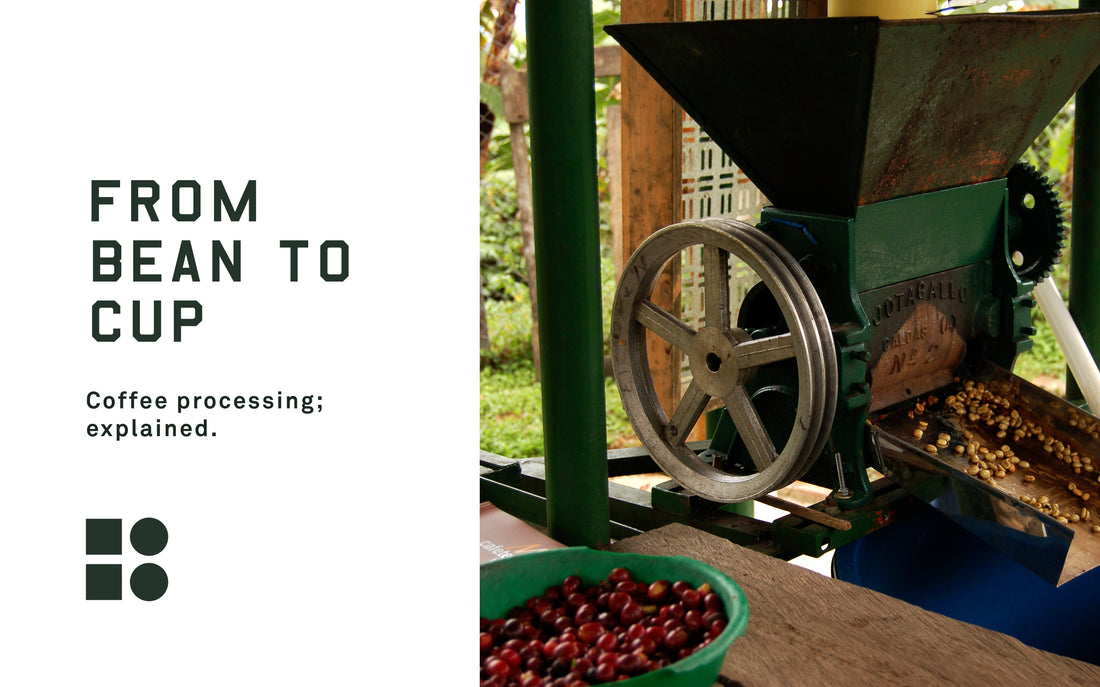Do you ever wonder how that delicious cup of specialty coffee arrives in your kitchen? Or have you ever heard about the different ways to process coffee and wondered what the differences are?
Welcome to the world of coffee processing!
Natural, washed and honey processing are 3 of the most common processing methods that you have probably come across. They are three unique approaches for preparing beans for roasting. For those curious about these processes, here's an introduction to each method and what makes them so special when it comes to crafting some truly amazing cups of specialty coffee!

Coffee Cherries
Many of us are familiar with coffee beans, but what about the coffee cherry? Coffee is actually produced from a seed that is found inside a fruit. This fruit is known as a ‘coffee cherry’ and its anatomy includes the pericarp, which has three distinct layers. The outermost layer is called the peel, which must be removed before roasting takes place. Then there’s the mucilage/pulp—a sticky substance that you can scoop away with your finger, followed by the parchment layer, which handles protection during storage.



Washed/ Wet processing

Processing coffee is an important process for any coffee farmer. Washed coffees are processed before drying and usually use water to remove the sticky layer of fruit surrounding the beans, revealing their aromas and flavors more clearly.
Generally speaking, washed coffees tend to be more consistent in flavor profile compared to natural coffees due to the increased control that the washed process gives producers. This makes them popular among farmers as they can produce a quality, consistent product in each batch rather than relying on factors such as ideal weather and harvesting conditions like with a natural process.
Natural/ Dry processing

Natural processing of coffee cherries is a labour intensive process, but results in a unique flavor profile. The first step is to discard any under-ripe or overripe cherries in a water tank. Then, farmers spread the remaining cherries out in flat, raised beds and leave them to dry in the sun. Throughout the process they continuously rake and turn them over to ensure they dry evenly and that no mould or rot develops. Depending on the climate, this process can last anywhere from two weeks to six weeks
.
This method originates from Ethiopia, where relatively low levels of precipitation perfect for natural drying. Although this technique yields complex and delicious flavours, these tend not to be as consistent from cup to cup compared to other methods of coffee processing.
What affect does process have on flavour

Naturally-processed coffees have complex aromas, with distinct flavour notes that make them stand out from other types of coffee beans. This is because the sugar content in the coffee cherry’s pulp contributes to the taste and aroma of these particular beans; their prolonged exposure to these sugars adds ripe fruit tones such as blueberry and strawberry on the nose. And even after brewing, you can enjoy a sweet, medium to full-bodied cup with hints of caramel or even chocolate in it!
Washed coffees stand in stark contrast to the profile of natural coffees, offering a decidedly more acidic flavour reminiscent of lemons and limes. This acidity cleaves through the sugars found in the pulp that naturally sweeten natural coffees, thus making it easier for drinkers to enjoy the bean’s intrinsic floral and spice notes, rather than having them overshadowed by sweetness. Additionally, washed coffees are generally pared down in body when compared to their naturally-processed counterparts; creating a mellower cup without sacrificing any flavor.
Honey Processed
Honey processing is a relatively new uniquely developed process of coffee making. It takes characteristics from natural and washed processed methods to create something entirely new - a hybrid of sorts. This method removes the bean carefully while leaving behind varying percentage of mucilage on the bean during drying. This translates to a final product that has full body notes, bright acidity, as well as well-rounded sweetness due to the remnant sugars left on the bean.
Different regions tend to use different methods based on what resources are available and climate conditions. For example, most coffees from Ethiopia are naturally processed because there isn’t much water available to wash the coffee cherries. South American countries like Colombia often produce washed coffees because they have an abundance of freshwater sources. Central America tends to produce honey-processed coffees due to high humidity levels which help prevent over-drying and preserve sweet flavors in the beans.

It's easy to get overwhelmed by all the different types of coffee out there, but once you understand the basics of processing, it becomes much simpler. Now that you know how coffee is processed, you can better appreciate all the hard work that goes into each and every cup!
Read more on how to make better V60 home brew.

Coffee processing is an amazingly complex, intricate skill and an art form in its own right. Every cup of freshly brewed coffee should be celebrated due to the sheer effort and dedication of those who create it.
By understanding the basics of how coffee is processed, you can enjoy a much fuller and more appreciative experience each time you savor a delicious cup – it’s a journey and story that makes drinking coffee so unique.
